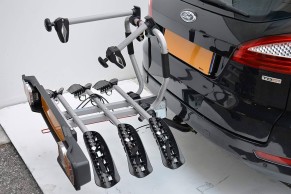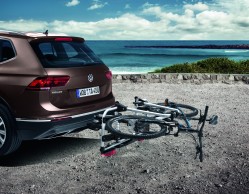Towball bike rack, a few things you should know before getting one
The towball bicycle rack is one of the best systems for transporting bikes in the car. It is the quickest way to load bikes, although those who choose to use it must adhere to some strict regulations. In this article we tell you a few things to be aware of before buying one.

Towball bicycle racks: pros and cons of one of the most sought-after solutions on the market
Most cyclists have been faced with the problem of loading the bike into the car. Many solve the problem by putting the bike in the boot, but this is useless when the boot is already occupied or when the bike is bigger than the boot itself.
The alternative of carrying them in the rear - at which point the rear seats are also usually folded down - requires strict compliance with the standard to avoid the associated dangers: lack of vision and difficulty of movement for the driver or freedom of movement of the load (which will cause it to move forward uncontrollably in the event of an accident).
RECOMENDADO

Complete list of the highest paid cyclists of 2025

How many calories are burned when cycling

What is heart rate variability and how does it affect the cyclist?

Change wheels if you want to transform your bike's behavior

What bike size do you need? Here's how to find out

How does age affect performance and recovery?
If there is no space in the luggage compartment, it is best to transport bikes on a bicycle rack. There are several options available on the market, including the towball or hitch bike rack.

The advantage of the towball bicycle rack is that it is stable, safe, offers a quick system for positioning the bikes and can - in most cases - open the boot with the bikes mounted. On the other hand, it is convenient to remove it when not in use.
The first step before buying it is to make sure you can install it in your car and to buy the right model in each case. There are three types: fixed, removable and retractable. The differences can be seen mainly in the price - the fixed ones are usually cheaper - and the aesthetics.

It is essential to know a basic rule: if the space occupied by the bicycle is less than the total width of the vehicle (including mirrors), a V-20 sign must be placed at the end of the load and perpendicular to the axis of the vehicle; if the bicycle occupies the total width of the vehicle, two V-20 signs must be placed, transversely at each end of the load and in such a way that they form an inverted 'V'.
The bicycle may not be transported if it protrudes beyond the maximum width, as it is forbidden for it to protrude laterally.
On the other hand, if the number plate or rear lights are covered, an additional plate with number plate and lights must be purchased for the bicycle carrier.

The regulation does allow the bike rack to protrude from the rear of the vehicle by up to 15% of the vehicle's length. The installation must be such that the bikes cannot fall, move, drag, produce dust, noise or other disturbances, according to the Traffic Department.
Finally, if after loading it in the car we cannot see through the interior mirror, it will be necessary to install an exterior mirror on the right-hand side.

It should also be noted that high exhaust gas temperatures can damage both wheels and rims - especially carbon rims - if the exhaust pipe is too close to them.
In addition to the hassle of complying with the regulations, the negative side of this system is its cost. This is the most expensive system, as in addition to acquiring the towball, it must also be homologated. In addition, we have to add the bike rack itself, the V-20 sign and other expenses.
However, in this type of case, and as long as our pockets allow it, it is better to value safety and comfort.